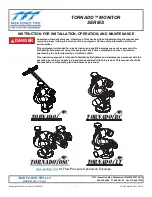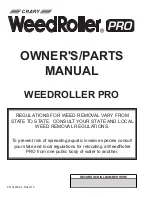
Aesculap
®
MINOP Intraventricular trocars
Legend
1
MINOP trocar (operative), FF399R
2
Single-obturator (for working channel)
3
MINOP trocar (diagnostic), FF398R
4
MINOP trocar (diagnostic), FF397R
5
Locking cap (obturator)
6
Obturator (for irrigation/drainage channels)
7
Obturator (for irrigation/drainage channels)
8
Guideway
9
Sealing caps
10
Obturator (optics and working channel)
11
Release button
12
Irrigation or drainage channel
13
Obturator (for optics channel)
14
Endoscope
15
Electrode
16
Instrument
Symbols on product and packages
Intended use
The MINOP trocars are used for endoscopic examinations and therapies in the central nervous system.
Indications
Indications, see Intended use.
Note
The manufacturer is not responsible for any use of the product against the specified indications and/or the described
applications.
Contraindications
None known.
Risks and side effects
As part of the legal duty to inform, the following typical risks and side effects associated with the use of surgical
instruments are referred to. These are predominantly procedure-specific, non product-specific and not limited to
unwanted damage to surrounding tissue resulting in e.g. bleeding, infection, material incompatibilities or instrument
parts remaining unnoticed in the patient, etc.
Available sizes
Safe handling and preparation
CAUTION
Federal law restricts this device to sale by, or on order of a physician!
Note
For the MINOP trocar system, there are specially developed Aesculap endoscopes available. For reasons of compatibil-
ity, the MINOP trocars may only be used with these special Aesculap endoscopes!
►
Ensure that the product and its accessories are operated and used only by persons with the requisite training,
knowledge, or experience.
►
Read, follow, and keep the instructions for use.
►
Use the product only in accordance with its intended use, see Intended use.
►
Remove the transport packaging and clean the new product, either manually or mechanically, prior to its initial
sterilization.
►
Store any new or unused products in a dry, clean, and safe place.
►
Prior to each use, inspect the product for loose, bent, broken, cracked, worn, or fractured components.
►
Do not use the product if it is damaged or defective. Set aside the product if it is damaged.
►
Replace any damaged components immediately with original spare parts.
►
For monopolar contact coagulation, make certain that the output power at the HF device does not exceed 50 W.
►
To avoid burns when using the ventriculoscope in combination with HF electrodes, ensure that HF current is acti-
vated only under visual control.
►
When using the HF electrode in combination with a flexible instrument, ensure that the working tips are kept as
far apart as possible.
►
Set the HF device to the lowest possible output power required for the intended effect.
►
Prior to each use, visually inspect the product for: damage or surface changes to the insulation.
►
Never place the product on or next to the patient.
►
Follow the instructions for use of the HF device.
Safe operation
Note
The endoscopes offered for application with the MINOP system must be used with a light source equipped with a spare
bulb!
Mounting the camera
Note
Mount the camera only with the endoscope locked in the working trocar!
►
Lock the endoscope in the MINOP trocar.
►
Mount the camera.
Demounting the camera
Note
Extract the endoscope from the working trocar only after the camera has been demounted from the endoscope!
►
Demount the camera from the endoscope.
►
Extract the endoscope from the MINOP trocar.
Disassembling
Removing the obturator (for optics and working channel)
►
Press the release button and carefully remove the obturator from the MINOP trocar.
Removing the obturator (for irrigation/drainage channels)
►
Turn the locking cap by 90° and carefully remove the obturator from the MINOP trocar.
Assembling
Inserting the endoscope/obturator
►
Carefully insert the endoscope/obturator in the MINOP trocar, making sure that the locking pin of the endo-
scope/obturator is on the same side as the release button of the MINOP trocar.
►
Insert the endoscope/obturator down to the positive stop.
Inserting the obturators (for irrigation/drainage channels)
Note
Be careful not to interchange the obturators. Mind the markings, "L" (= left-hand obturator) and "R" (= right-hand
obturator)!
►
Hold the obturators at the distal end and carefully slide them into the respective channels, down to the positive
stop. Ensure that the guideway on the obturator is aligned with the pin in the main body of the MINOP trocar.
►
Turn the locking cap by 90°.
Validated reprocessing procedure
General safety notes
Note
Adhere to national statutory regulations, national and international standards and directives, and local, clinical
hygiene instructions for reprocessing.
Note
For patients with Creutzfeldt-Jakob disease (CJD), suspected CJD, or possible variants of CJD, observe the relevant
national regulations concerning the reprocessing of products.
Note
It should be noted that successful reprocessing of this medical device can only be guaranteed following prior valida-
tion of the reprocessing method. The operator/reprocessing technician is responsible for this.
The specified chemistry was used for validation.
Note
For up-to-date information about reprocessing and material compatibility, see also the Aesculap Extranet at
www.extranet.bbraun.com.
The validated steam sterilization procedure was carried out in the Aesculap sterile container system.
Caution, general warning symbol
Caution, see documentation supplied with the product
Designation
Art. no.
MINOP trocar (diagnostic)
FF397R
MINOP trocar (diagnostic)
FF398R
MINOP trocar (operative)
FF399R
WARNING
Risk of injury and/or malfunction!
►
Always carry out a function check prior to using the product.
WARNING
Risk of injury when using the product beyond the field of view!
►
Apply the product only under visual control.
WARNING
Risk of injury caused by protruding 30°-endoscope in locked position!
►
Insert the endoscope only when the trocar is in its final position.
WARNING
Risk of burns due to high temperature of the instrument-side end of the optical
cable of a light source!
►
Apply proper care when operating the light source.
CAUTION
Damage to the endoscope due to incorrect handling or operation!
►
Insert the endoscope in the MINOP trocar only if the trocar is not deformed,
bent or kinked.



































